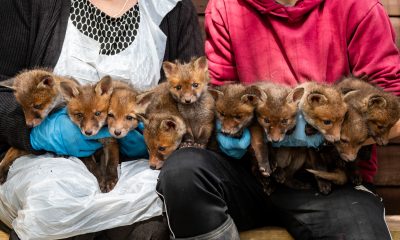Dolphins, fishermen land bigger catch when working together: study
"This is a mutually beneficial interaction."
Published
1 year ago onBy
Talker News
By Stephen Beech via SWNS
Dolphins and fishermen each land a bigger catch when they work alongside each other, reveals new research.
Fishing in synchrony brings "mutual benefits" for both the aquatic mammals and people in Brazil, according to the findings.
However, researchers warned that the unique style of fishing is in danger of dying out.
Scientists concluded, following 15 years of study of the practice, that, by working together, dolphins and net-casting fishers in Brazil each catch more.
They say that it is a rare example of an interaction between two top predators that is beneficial to both parties.
Study leader Dr. Mauricio Cantor, of Oregon State University, said: “We knew that the fishers were observing the dolphins’ behavior to determine when to cast their nets, but we didn’t know if the dolphins were actively coordinating their behavior with the fishers.
“Using drones and underwater imaging, we could observe the behaviors of fishers and dolphins with unprecedented detail and found that they catch more fish by working in synchrony.
“This shows that this is a mutually beneficial interaction between the humans and the dolphins.”
Dr. Cantor explained that synchronized movements of flocks of birds and schools of fish are a common yet striking behavior that can be key to the animals’ survival.
However, synchronized behavior between species, such as that between the Lahille’s bottlenose dolphins and the traditional net-casting fishers in Brazil, is much rarer.
The practice is considered a cultural tradition in the city of Laguna on Brazil’s southern coast, where it occurred for more than 140 years and has been passed down through generations of fishers and dolphins.
Dr. Cantor said the cooperative fishing relationship is specific to this population of dolphins and is not a genetic trait in the animals.
He says there are historical and recent accounts of similar behavior in a few locations elsewhere in the world, but the practice is in decline or has disappeared completely in most places and remains almost completely unstudied in others.
Dr. Cantor said: “From the fishers’ perspective, this practice is part of the culture of the community in all kinds of ways.
“They acquire skills passed down from other fishers and knowledge is spread through social learning.
"They also feel connected to this place and have a sense of belonging to the community.”
Predictive models run as part of the study show that the future of the practice could be threatened if populations of mullet – the type of fish both dolphins and people are seeking – continue to decline, or future generations of fishers lose interest in learning the art of the unique fishing practice.
Study co-author Professor Damien Farine, of the University of Zurich in Switzerland and the Australian National University, said: “The practice is unlikely to continue if either the dolphins or the fishers no longer benefit from it."
Professor Fábio Daura-Jorge, of the Universidade Federal de Santa Catarina in Brazil, revealed that researchers are already seeing early signs of decline in the practice.
He said: “If we take steps to document and conserve the knowledge and the culture of the practice, we can indirectly and positively impact the biological aspects, as well."

The research team combined drones, hydrophones and underwater cameras to capture the mechanics of the partnership, conducted long-term demographic surveys for dolphins and interviewed and observed the fishers.
Their findings, published in the journal Proceedings of the National Academy of Sciences (PNAS), show that foraging synchrony between dolphins and fishers "substantially increases" the probability of catching fish and the number of fish caught.
The benefit then supports the dolphins’ survival as those who engage in cooperative fishing in the area have a 13 percent increase in survival rates – and the financial well-being of the fishers.
The researchers also found that the fishers’ understanding of the fishing tradition matched the evidence produced through scientific tools and methods.
Dr. Cantor said: “Questionnaires and direct observations are different ways to look at the same phenomenon, and they match up well.
“By integrating these together, we could then get the most complete and reliable picture of how this system works and, most importantly, how it benefits both fishers and dolphins.”
Prof. Farine said most interspecific interactions, including those between humans and other animals, are competitive rather than mutually beneficial, but not in the case of the dolphins and fishers.
He added: “This makes this system of substantial scientific interest, as it can help us to understand under what conditions cooperation can evolve and – of growing importance in our rapidly changing world – under what conditions it might go extinct, or flip from a cooperative to a competitive interaction.”

The researchers suggest conservation action is needed to ensure the future of the practice.
Both the dolphins and the fishers are reliant on a strong and healthy fish population for the cooperative relationship to succeed.
But in recent years, the region has seen reduced availability of fish.
And Prof. Daura-Jorge warned that there is also reduced interest in learning the tradition.
He said: “We don’t know what is going to happen in the future, but our best guess, using our best data and best models, is that if things keep going the way they are right now, there will be a time when the interaction will no longer be of interest by at least one of the predators – the dolphins or the fishers."
Dr. Cantor added: “This phenomenon of mutually-beneficial interaction between wildlife and humans is getting more and more rare and seems to be at global risk.
“The cultural value and the biological diversity are important, and it’s important to preserve it.”
Stories and infographics by ‘Talker Research’ are available to download & ready to use. Stories and videos by ‘Talker News’ are managed by SWNS. To license content for editorial or commercial use and to see the full scope of SWNS content, please email [email protected] or submit an inquiry via our contact form.
You may like


Scientist transforms climate change data into classical music


Breakthrough may help unlock way to prevent diabetes


Having this type of job could reduce risk of memory issues


Study claims AI better than doctors in accurately assessing eye problems


Remains of possibly largest marine reptile ever found on beach


7 out of 10 teens on Twitter get bullied over their weight
Other Stories


Touching moment brother and sister reunite after 45 years
"I didn't realize it had been so long."


Meet the 2-year-old chef obsessed with cooking shows
She started cooking when she was 11 months old alongside her mom.


Man running marathon after learning how to walk again
He was in a coma for three weeks after he suffered a fall in October 2020.


Couple find medieval gargoyle imp hiding in their bathroom
The couple took to social media for answers.


Farmer finds ‘unprecedented’ litter of 10 fox cubs
The farmer accidentally dug up their den while working.
Top Talkers

 Food & Drink1 week ago
Food & Drink1 week agoWe eat enough grilled cheeses a year to fill 900 Olympic swimming pools

 Broadcast1 week ago
Broadcast1 week agoOver 50% of Americans trust Google more than their schooling

 Parenting20 hours ago
Parenting20 hours agoSingle mom details struggles of feeding her 12 kids

 Broadcast1 week ago
Broadcast1 week agoAmericans eat enough grilled cheeses a year to fill 900 Olympic swimming pools

 Broadcast3 days ago
Broadcast3 days agoOver 40% of Americans have no clue what a 401k is

 Broadcast1 week ago
Broadcast1 week agoGrocery shopping hungry is costing Americans this much

 Funny1 week ago
Funny1 week agoCops confused by crow mimicking police siren

 Broadcast2 days ago
Broadcast2 days agoHow hard is it for Americans to live sustainably?
